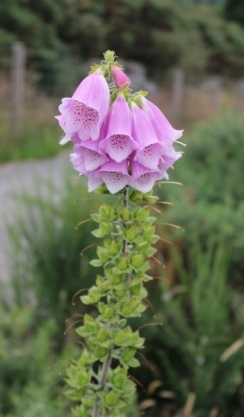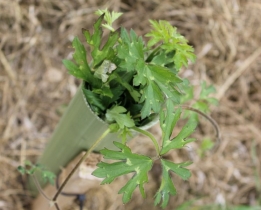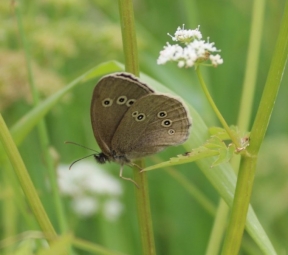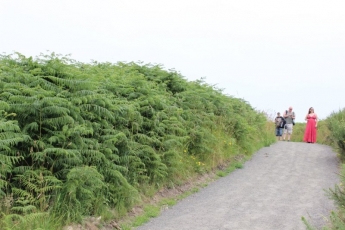On Sunday the 21st of July a small group of people, previously brought together by their concerns regarding the culling of roe deer as part of the controversial ‘Tree for Every Citizen’ project, visited Tullos Hill. Fred Wilkinson reports.
The group wanted to take a look at what had changed since the culling of the deer and the planting of the trees. There was considerable upheaval associated with these, as well as the removal of vegetation and the erection of fences.
Armed with half a dozen cameras, from mobile phone additions to expensive professional devices, the group also wished to create a visual record of the beauty of the area and the wildlife in evidence.
As we walked along the top of the hill from the Altens Farm Road entrance, one of the first things we observed was that a vast area which months before had been quite brutally cleared of gorse, and all other vegetation for that matter, was now covered by new growth and crowned by an impressive display of foxgloves.
Various grasses and other common wild native plants contribute to the cover, making the area immeasurably more pleasant than it was the last time we had stood there.
The area in question has not been planted with trees, and therefore the reason for clearing it would seem to have been in order to expose deer to the marksman charged with culling 46 deer, of a population officially reported to have been around 30.
A less pleasing consequence of the clearing of gorse however is the spectacular spread of bracken, crowding out almost any other species of plant over a huge area where once was a much more varied range of wildlife alongside the gorse. This is quite an own goal, and would have been more so if further deer culls were planned. This is because bracken is significantly more efficient than gorse when it comes to hiding deer.
Additionally bracken is recognised as a potential fire hazard, and a plant which is poisonous to mammals, including humans. One wonders why it has been allowed to grow over such a huge area, obscuring previously visible minor footpaths, as well as views across the hill – now visible only to those individuals exceeding or approaching six feet in height.
Julie Thompson took advantage of the cairn to gain height and to take some pictures not only of the spread of the bracken, but also of the superb view over Tullos, Torry and the rest of the city.
We then made our way down the hill to the picnic area, having gathered shots of the many wildflowers including wild pansy, ragwort, tufted vetch, coltsfoot, dame’s violet, at least two varieties of buttercup, bird’s foot trefoil, kidney vetch, white clover, spear thistle, various white umbellifers including cow parsley and hogweed, ox eye daisy, rosebay willowherb, broad leaved willowherb, stinging nettle and groundsel.
We were already appreciating the variety of plant life in what is a mixed habitat. For all the gorse, broom and that invasion of bracken, there is room on the hill for all. Except deer it would seem.
Julie Thompson commented:
“Having previously visited shortly after the deer had been slaughtered, it was nice to see that the hill had recovered somewhat from what had appeared to be a scorched earth program. It’s such a shame that so much of the gorse – a fantastic habitat for birds & small mammals – has been superseded by bracken.”
At this point, we discussed the apparent lack of animal life. There is no evidence of deer, but rabbit droppings can be seen occasionally.
There is no shortage of insects and spiders, and it is heartening to see so many bees of at least 4 different varieties.
There is also evidence of snails, ants, grasshoppers, froghoppers, ladybirds, aphids, various flies and wasps including the rather creepy ichneumon wasp, which along with the sightings of moths and butterflies, including ringlets, small tortoiseshells, and small whites, suggested that there were caterpillars and other larvae to prey on.
However, compared to what we had witnessed on previous visits, birds seem scarce.
Julie Thomson observed:
“During the couple of hours that we were there, I only saw three or four small birds (gulls are everywhere, I don’t count them). For an area such as this, that is pretty shocking and just goes to show what damage has been done by removing so much of the gorse.”
On our first picnic two years ago, as well as the noticeable presence of small birds, a kestrel could be seen patrolling the north side of the hill. This predator was a good sign in that it was being sustained by a healthy number of smaller animals.
Lower down the hill, we encountered some different plants. We found poppies, smooth sow thistle, pineappleweed, scentless mayweed, knapweed, sedges, cleavers, dandelion, tormentil, shepherds purse, hawkweed, mouse-ear chickweed, dock, rats tail plantain, ribwort plantain, and red clover.
I was particularly excited to find a double buttercup.
I have no idea how frequently this occurs outwith an environment concerned with the cultivation and the specific aim of producing double-flowered varieties of plant, but this was certainly the first I had ever witnessed in a natural environment, albeit a reclaimed landfill site.
I spot droppings which suggested evidence of a fox, but knowing that the hill is popular with dog walkers, and lacking spectacles stronger than I need for anything other than reading, and also lacking the expertise to determine for certain the origin of said poo, I decided against pulling it apart.
However I am happy to entertain the possibility that there are foxes there, and the abundance of another sort of poo suggests that there is a population of rabbits sufficient to sustain a small number.
By now we can see the recently planted trees, or at least, we see an abundance of upright green cylinders. Each has its own story which contributes to the bigger picture.
The good news is that most of the trees that we saw were alive, although few appeared to be thriving.
Ironically, the area where last year’s mock funeral for the deer took place appeared to have the largest proportion of dead trees.
http://www.accessmylibrary.com/article-1G1-288243902/mock-funeral-staged-protest.html
Then there are the trees we didn’t see, or rather couldn’t see, as they were obscured by weeds inside their tubes.
Whether those trees are alive or dead is anyone’s guess, but what is clear is that their chances of survival are compromised at the very least.
We had agreed that we were there to observe, discuss and record, and not to disturb or interfere with anything.
We therefore refrained from removing weeds to look for the trees, ensuring zero possibility of any action on our part causing damage to trees or their protective tubes.
We examined an area which remained stripped of vegetation other than weed filled tubes and dead trees, the soil exposed to reveal an array of household and industrial waste.
On seeing the half-buried plastic bags and containers, various scraps of metal including what appeared to be an industrial steel cable and a rusted steel rod which would have been used once to reinforce concrete, Torry resident Sheila Anderson commented:
“I am glad I never saw what the hill was like before the planting, I would have been so upset right now”
Unfortunately, unable to evaluate those weed-hidden saplings, which make up a sizeable proportion of the plantation, it is impossible to put an accurate figure on the percentage of trees which have survived so far. However the scale of neglect is abundantly clear.
Alex Mitchell commented:
“It looks like the deer were doing us a favour controlling the weeds.”
We saw many tubes with plumes of weed growth sprouting from them. Often it was as if we were looking at small sturdy trees with green plastic trunks and a lavish crown of weed growth.
I had barely started writing this report when I learned that Councillor Jean Morrison, on behalf of Aberdeen City Council, has collected a commendation in the New Native Woods Awards relating to the tree planting on Tullos Hill.
Difficult as it is to evaluate the general health of the newly planted trees, no-one in our party regarded what we saw as worthy of winning an award, leaving us wondering what criteria were applied, and what observations were carried out and
when.
I have since emailed Councillor Morrison and await answers to a series of questions of questions relating to the above. Some 10 days on, I still await answers.
We were promised a tree for every citizen.
46 deer were killed to facilitate this pledge. Large areas of vegetation, which constituted a habitat for a great many birds, mammals, insects and other animals were removed.
However we evaluate this it is certain that the number of trees which have survived falls embarrassingly short of the number of citizens. It is also certain that deer have played no part in the failure of trees to survive.
Having a fairly good knowledge of native wild plants, it was apparent to me that some of the weeds we saw growing up inside the tubes had reached heights that they would not have achieved naturally. Without the support of the tubes, the effect of wind, and their own weight would have limited their height, making them more likely to offer the neighbouring trees the required space and light to sustain them.
It appears that no management whatsoever of the plantation has been carried out since the trees were put into the ground.
I must make it clear that although I and a great many others were opposed to the Tullos Hill deer cull, no-one has expressed to me any wish for the trees to fail.
That would not bring back the deer, and would result only in taxpayers’ money being used to pay back the grant on account of failed planting, as has happened previously.
Rather, we believe that as the trees have been planted, already at great cost both in terms of finance, damage, and a number of animals which were once considered of sufficient value to grace the pages of council-produced tourist information brochures, that the council has a duty to each citizen for whom they planted a tree, to manage the plantation and ensure the survival of as many trees as possible, and to replace every single casualty.
Suzanne Kelly reacted:
“We paid the consultant some £70K for this; we also had to repay £43,800 for the first tree planting which failed. The causes of failure were listed as deer, wrong size of tree guards, and importantly failure to keep weeds in check.
“The deer were destroyed for this scheme, and it is very disturbing that no one is looking after the trees. We all saw the condition of the soil on Sunday – it is filled with large stones and industrial and household waste.
The soil matrix was of concern to the Forestry Commission, too. If the trees don’t take in the end, and I don’t believe they will, I want those responsible for forcing this scheme on us to be held accountable.”
Having examined hundreds of trees and weed filled tubes over a wide area, we made our way back along the north part of the hill, finding more plant species to add to our list. Self heal, creeping thistle, sorrel and yellow rattle were visible in the grassy meadow areas, and as we approached the wooded part to the west, we encountered areas of boggy moorland with mosses, browned from the recent dry conditions, and heathers.
Having gathered hundreds of photographs and seen first hand the ‘lie of the land’, we discussed our mixed feelings about our findings.
On the bright side, despite the poor soil which covers much of the hill, particularly that part which was formerly landfill, there is an impressive variety of plant life providing stunning displays of colour and interesting fragrances. Added to that spectacle there is also the impressive view over the city which few locations can equal.
It stands to reason that if the wild areas are left to develop naturally, more species of plants and animals will find a niche in such a diverse habitat.
There is also evidence that the trees, if managed properly, can survive, at least in some areas. Their growth is likely to be slow, and they will not achieve their natural height.
The bracken is of concern. Bracken certainly has its place, but unchecked, it dominates, squeezing out other plants, and also any animal species associated with those displaced plants. If there is any regime of management of the Tullos Hill environment, this needs to be examined and acted on.
With the fine weather we have enjoyed over the past fortnight looking likely to continue, at least intermittently, I recommend to anyone who has not set foot on Tullos Hill to do so and see for themselves that in spite of the less pleasing aspects I have mentioned, this is indeed a beautiful and unique part of our city well worth speaking up for in order to preserve its uniqueness for future generations – for plant and animal as well as human to enjoy.
- Comments enabled – see comments box below. Note, all comments will be moderated.









Great report, Fred. In particular, the effective replacement of gorse by bracken seems nothing short of disastrous!
A wonderful, knowledgeable, comprehensive and fair-minded report with excellent photographs, tinged with great sadness at the mindless and ignorant destruction which has gone before. Many congratulations on this very useful update on the present situation.
It might be worth investigating how well the conifers are doing in the enclosures above Ballgownie playing fields. Fine regeneration of natural meadow, but the saplings are few and far between and are being totally swamped by the grasses and as fine a crop of dandelions as I have ever seen.
All in all, I think we can agree that the project was a complete and utter waste of tax payers money. Nothing seems to have been learned from the St Fittick’s venture which could be best described as a failed attempt at reforestation, costing the public purse dear. I’m in total agreement that those who perpetrated this extravagant waste of public funds should be held to account. Regretably, award for failure have become the norm nowadays.
What I found most amazing from that day trip was that nature regardless, will still blossom, even in landfill. In some areas how anything grows at all is a wonder in itself.
Whoever was responsible for master minding the project had no environmental sense what so ever? We could take that further. Diversity what’s that. No thought has gone into how those (for a large part) shrivelled up examples will grow. A tree for every citizen, where? not on them thar hills.
For the record, Cllr Jean Morrison has mailed me her response today. I am still studying the contents, but thought it fair to acknowledge it here as soon as I could.
It is maybe a bit hard for those of us who are city dwellers to understand, but bracken is a native British fern commonly found in woodland and heath land. It is pretty much impossible to eradicate and is part of the Scottish countryside like it or not. A fire hazard? I think not. Poisonous to mammals? Perhaps but who amongst us would fry it up for breakfast?
As to the culling of deer, that is debateable on many grounds. Deer both eat and destroy saplings by rubbing off the velvet from their antlers. They also enhance woodland by creating clearings which allow colonisers such as birch and sycamore to establish. The usual response from land managers is to cull, build deer fences or enclose plantings in 1.2m tubes. Any or all are effective against Roe Deer but only fences and culling are proof against Red Deer.
Gorse and indeed Broom are certainly contentious. We love them and hate them in equal parts. The severe winters of 2010 and 2011 destroyed much of the Scottish Gorse and Broom stock but again that is part of the natural cycle and has allowed the colonising Birch and Sycamore to seed and flourish in the landscape.
Tullos Hill is a changing environment and the human impact has been severe in the past as the four Bronze Age cairns suggest.
In this extract from the “Book of St. Fittick”, published in 1902, Dr. Thomas White Ogilvie describes what the scene looked like in his day.
“full of quiet charm, this little glen, with its Kirk on the height and its Kirk in the hollow, extending from the great gap in the cliff, which forms the Bay, up to the river, where, with majestic bend, it sweeps glittering and gurgling by Allenvale and Duthie Park, sweetest of resting places for the quick and the dead”
Perhaps a re-evaluation of this Voice article is due.
Picnic anyone?
A very interesting take; and there are those in the Council who’d love it if people forgot what has gone before. For openers, there is the forestry commission’s own soil report covering the pollution and the rocky soil matrix; trees that do grow over the domestic and industrial waste will be likely to fall over because of the soil matrix in the wind. Community councils in the area opposed the scheme when it emerged its proponents had deliberately hidden the deer cull from the public consultation. The public consultation for phase 2 of the ‘tree for every citizen’ scheme ignored the £43,800 which the city was forced to repay for the failure of phase one. The causes of the failure were acknowledged to include weeds as well as deer browsing. The weed issue is not being addresses; weeds are overtaking the saplings. The deer could have been humanely dealt with; the trees did not have to go on Tullos in the first place; but perhaps the LibDems were keen to keep at least one of their election pledges, and Aileen Malone insisted the scheme would go ahead. She prevented me and (happily now councillor) Andy Finlayson from addressing the committee she convened when we had fresh information (the cull, the cost of the failure, etc) which could have shed new light on the realities – she used the rather disingenuous excuse that since she had only called for a verbal report on the deer / tree situation, no one was allowed to address the committee. A vote was taken and almost everyone save the labour councillors voted against letting us speak. So much for open government. Twenty deer were to have been culled; 34 or 35 were killed – but the record-keeping was so poor we don’t actually know. Consultant Chris Piper got at least £70k for his work on this project; he produced a report that said a small but vocal minority were against the scheme: ignoring the petition signed by about 3.5K people and the opposition of the community councils. The existing ecosystem before the tree scheme was launched saw deer migrating on and off the hill for at least 70 years without the need for a cull; smaller mammals were driven off the hill when the bulldozers came in; and bracken now replaces the gorse that housed and fed these animals and many bird species – many of which were on the RSPB’s list of birds which are in danger of significant population decrease. The hill was a rubbish tip (including radioactive waste) which had turned into an improving meadow; we’ve allowed a small handful of people to turn it into a poor looking tree experiment where gorse is now replaced by bracken. For those interested in the history of what happened here, here’s the link to my report http://suzannekelly.yolasite.com/ . The then city council went out of its way to disregard the elected community councils, the science, the thousands who signed the petition, and the right of the deer to continue peacefully. When this current crop of trees eventually fails – whether early in their growth cycle because of the weeds or later, when the 90+ mph winds and salt spray do their work – we’ll be out of more money. This to me was a hugely wasteful, cruel, unscientific project all to please the LibDems and make their ‘tree for every citizen’ election plank look good. Let’s not forget what happened here, so we can make sure it doesn’t happen again.
I think that we are talking about quite different issues here. The politics of local conservation are perhaps needing to be set aside. The hill and its resident population of wildlife do need our understanding and support but perhaps in a more laid back way. Let it grow back without too much human interference perhaps.
Your point about what has gone before is of course valid. But perhaps in the long term, and I mean the very long term, it would be better to let nature take its course.